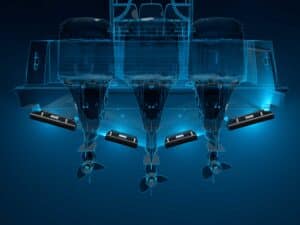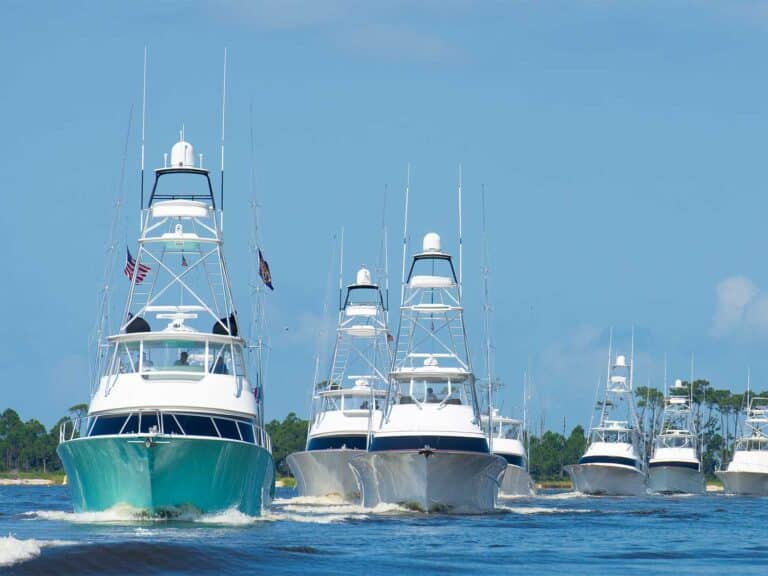In our never-ending pursuit of good fishing and fun, we continually add elements to our operation that make things more interesting and offer new opportunities. Towing a skiff behind your sport-fisherman offers a great deal of variety and good times – especially when you have guests to entertain.
Setting up for sage and proper towing takes a bit of preparation and requires equipment that can withstand a great deal of pressure. We set up our 36-foot Yellowfin center console to tow behind Brier Patch, and had a great time doing things that we could never have done on the big boat. The little-boat option really makes a trip, since you can adjust your fishing style to fit the weather and keep your guests engaged – even if you have a cast of thousands on board.
The key to towing is picking a boat that can realistically accomplish what you would like it to do, be it fishing, shuttling guests around, diving or something else. The boat has to be a size that your big boat can tow without strain, and built well enough to withstand the rigors of towing. A lot of boats don’t have the overbuilt construction required to withstand the different stresses and forces at work on a boat under tow. Any boat under tow must be able to take a beating for long periods of time when the weather turns rough.
As far as the boat doing the towing, it’s obviously important to know what kind of load it can pull. If you tow a 12,000-pound, 30-foot-plus skiff, you need to know that your cleats can handle the strain and that your engines can withstand the additional load. Make sure that your boat can control the tow at all times, and that the tail (the boat being towed) does not wag the dog (the big boat doing the towing).
You don’t want the tow boat working so hard that you diminish your range with the additional fuel burn or, even worse, make the engines work harder than they should, breaking down lubricants and wearing internal engine parts. Understanding the relationship between the tow boat and the boat being towed will go a long way toward making it all work properly.
One thing that you absolutely need to have is a good towing eye on the boat being towed. There’s no getting around this one – you simply cannot tow a boat from its cleats over long distances; the angle is all wrong for clean and effortless towing. Pulling from the cleats puts downward pressure on the bow and causes the boat to bow steer and plow, making for an unwieldy tow. Few boats come with cleat installations that can handle the pressure over time. Towing from the trailer eye is also not an option, since few come with backing plates installed and the eye will rip out. And again, most trailer eyes are typically installed too high off the water to provide a good tow angle.
Installing a properly made towing eye at, or slightly above, the water line offers the best pulling angle and helps keep the force of the tow line from pulling the bow down and creating more drag. There are no generic towing eyes; you must have one fabricated to fit the shape of your particular boat.

Twin tow lines, a quick-disconnect shackle retriever and the use of Tigerflex hose as chafing gear complete a slightly complicated, yet safe, tow system.
Typically, towing eyes are made out of stainless steel and fasten to the boat at the bow, with a single hole to pass the pin of a shackle through. This method is widely used, but is not optimal. I have seen cases where the pins bend, and in some instances shear off, due to the tremendous force on the pin in the hole as everything hinges on that one point.
To reduce the amount of strain on the pin, we made ours with two sections of stainless plate that mount to the hull via a heavy stainless rod that is bent and welded to the plates. This method allows the ring of the tow shackle to float and move on the rod without hinging. And since the pin is passed through the eye of the tow line as opposed to going through the hole, it eliminates the high stress on the pin and hole.
We had our tow line made by the folks at National Marine Suppliers in Fort Lauderdale. For the main line, we use a 12-strand plasma line 58 inch by 100 feet with soft eyes and chafe gear sewn on both ends. This rope boasts a tensile strength of 51,400 pounds. The plasma line reduces stretch and decreases drag since it sports a smaller diameter to tensile-strength ratio. At the front end, we attached two 60-foot harness lines made of 118-inch, black double-braid nylon, with a soft eye and chafe gear on one end to connect the main line, and with the tow-boat ends whipped and left open for easier adjustment on board the tow boat. The nylon harness lines have a tensile strength of 44,900 pounds.
To quickly disconnect from the tow line and run the skiff when it’s time to dock, we use a 12-foot piece of the 58-inch plasma line that serves as a connecting line to the boat, with an eye and shackle at each end. This allows us to leave the connection at the waterline tow eye attached, undo the shackle to the main line, and then tie the connecting line to one of the bow cleats. This connecting line has a 15-foot length of ½-inch black double braid to pull in the shackle at the connecting line/main line joint, so you can disconnect easily.

For our shackles, we used 78-inch Crosby G-209A alloy galvanized shackles – they are stronger than stainless-steel shackles, with a weight-lifting limit of 9.5 tons. We carry spare shackles and pins for each connection in case one is dropped overboard when making the transfer. We also use a piece of Monel wire to secure the pin to the shackles so they do not unwind, vibrate and come loose in transit. Since our hawse pipes are in the corners of our transom leading to our cleats, we use Tigerflex hose as chafe gear, where our harness lines come through the transom to the cleats to prevent any excessive wear on the harness lines. A chafed line can create a bunch of problems in a hurry. We are always looking at preventative solutions to keep from creating an issue while under way.
A great idea we adopted from Capt. David Doll, who tows a 36-footer behind a 161-foot yacht or the 80-foot Reel Wheels sport-fisherman, is to install a flashing light on the hardtop connected to the boat’s high-water alarm, so that if the tow is taking on water and the batteries have been drained and cannot keep up with the incoming tide, the flashing light will warn you of the trouble brewing below.
Another common-sense idea that we got from Capt. Gary Stuve, who tows a flats skiff back and forth from the Bahamas and the Keys behind a 58-footer, is to install a car’s rearview mirror on the bridge so you can glance up and see the boat in tow while still facing forward.
Being prepared, looking for the weak link in the system and making it better, and approaching the whole process sensibly make the daunting task of towing little more than another part of the transit. And once you get to your destination, you have another great weapon in your entertainment, and fishing, arsenal.
**Contact
**National Marine Suppliers
www.nationalmarinesupply.com







